Themed collection Bioorthogonal and click chemistry: Celebrating the 2022 Nobel Prize in Chemistry

Click chemistry in the synthesis of catalytically relevant organoselenium compounds: development and applications of catalysts for organic synthesis
Use of click chemistry in synthesizing organoselenium compounds and the applications of metal complexes of such compounds as catalysts for various chemical transformations have been critically analyzed.
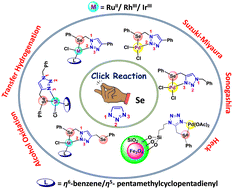
New J. Chem., 2022,46, 14757-14781
https://doi.org/10.1039/D2NJ02364D
When CuAAC 'Click Chemistry' goes heterogeneous
Within the green chemistry context, heterogeneous catalysis is more and more applied to organic synthesis. The well known ‘click chemistry’ and especially its flagship, the copper-catalyzed azide–alkyne cycloaddition reaction (CuAAC), is now catch up by such heterogenisation process and copper ions or metals have been grafted or deposited on or into various solids, such as (bio)polymers, charcoal, silica, zeolites, POM or MOF.
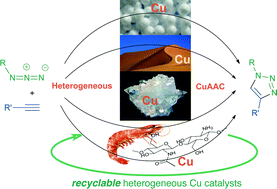
Catal. Sci. Technol., 2016,6, 923-957
https://doi.org/10.1039/C5CY01847A
Photo-controllable bioorthogonal chemistry for spatiotemporal control of bio-targets in living systems
The establishment of photo-controllable bioorthogonal chemistry is one of the most significant advances in chemical biology to perturb and study biological processes.

Chem. Sci., 2020,11, 3390-3396
https://doi.org/10.1039/C9SC06540G
Imaging beyond the proteome
In this review, we discuss some of the recently developed chemical technologies that enable imaging beyond the proteome.
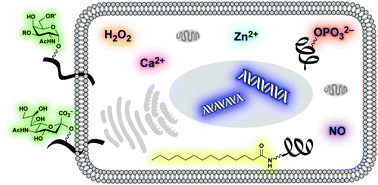
Chem. Commun., 2012,48, 8864-8879
https://doi.org/10.1039/C2CC31845H
Labeling and sequencing nucleic acid modifications using bio-orthogonal tools
Labeling nucleic acid modifications using bio-orthogonal tools, then sequencing and imaging the labeled modifications in DNA and RNA.
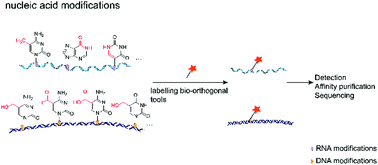
RSC Chem. Biol., 2022,3, 994-1007
https://doi.org/10.1039/D2CB00087C
Bifunctional chelators for radiorhenium: past, present and future outlook
This review highlights some of the past and current bifunctional chelators developed for radiorhenium (186Re and 188Re), as well as providing an outlook on what we may expect in the field of rhenium radiopharmaceuticals in the future.
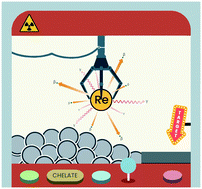
RSC Med. Chem., 2022,13, 217-245
https://doi.org/10.1039/D1MD00364J
Metal-free bioorthogonal click chemistry in cancer theranostics
In this Review, recent progress in cancer theranostics on the basis of metal-free bioorthogonal click chemistry is depicted in detail and future prospects in this emerging field are emphasized.
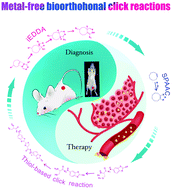
Chem. Soc. Rev., 2022,51, 1336-1376
https://doi.org/10.1039/D1CS00451D
Derivatization based on tetrazine scaffolds: synthesis of tetrazine derivatives and their biomedical applications
The recent advances in tetrazine scaffold-based derivatizations have been summarized. The advantages and limitations of derivatization methods and applications of the developed tetrazine derivatives in bioorthogonal chemistry have been highlighted.
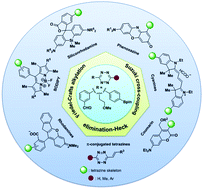
Org. Chem. Front., 2022,9, 481-498
https://doi.org/10.1039/D1QO01324F
Bio-click chemistry: a bridge between biocatalysis and click chemistry
This review summarizes chemo/biocatalytic syntheses that combine the highly efficient click chemistry reactions with the advantages of biocatalysis. The concept of bio-click chemistry and its implications are introduced in this review.
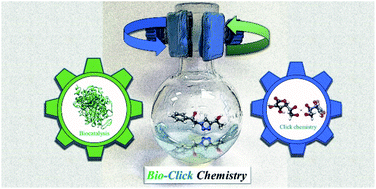
RSC Adv., 2022,12, 1932-1949
https://doi.org/10.1039/D1RA08053A
Recent advances in Cu-catalyzed transformations of internal alkynes to alkenes and heterocycles
Numerous metal-catalyzed reactions involving internal alkynes and aimed towards synthetically and pharmacologically important alkenes and heterocycles have appeared in the literature.
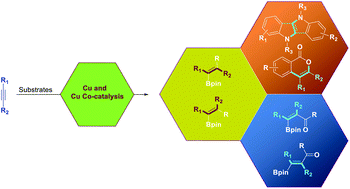
Org. Biomol. Chem., 2021,19, 10259-10287
https://doi.org/10.1039/D1OB01709H
Interrogating the transcriptome with metabolically incorporated ribonucleosides
This review summarizes recent developments in metabolic labeling of RNA to study RNA synthesis and turnover, RNA binding proteins, and RNA modifications and modifying enzymes.
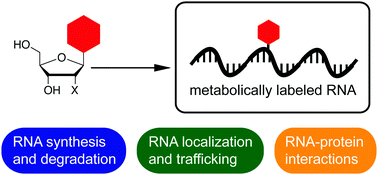
Mol. Omics, 2021,17, 833-841
https://doi.org/10.1039/D1MO00334H
Click-functionalized hydrogel design for mechanobiology investigations
This review article covers the use of click chemistries toward the design of dynamic and instructive hydrogels for understanding cell mechanobiology.
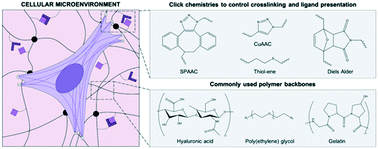
Mol. Syst. Des. Eng., 2021,6, 670-707
https://doi.org/10.1039/D1ME00049G
Fluorescent labeling of biocompatible block copolymers: synthetic strategies and applications in bioimaging
This review describes the different chemical approaches and strategies to fluorescently label block copolymers. The review also focuses on the properties of fluorescent markers and the bioimaging applications allowed by the labeling.
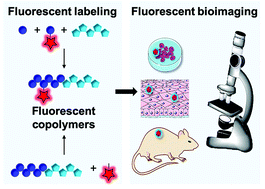
Mater. Adv., 2021,2, 3213-3233
https://doi.org/10.1039/D1MA00110H
Recent advances in bio-orthogonal and dynamic crosslinking of biomimetic hydrogels
This review highlights recent advances in bio-orthogonal and dynamic hydrogels crosslinked by irreversible click chemistry, enzymatic reactions, and covalent-adaptable network.
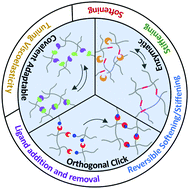
J. Mater. Chem. B, 2020,8, 7835-7855
https://doi.org/10.1039/D0TB01429J
Chemical proteomics approaches for identifying the cellular targets of natural products
This review focuses on chemical probes to identify the protein binding partners of natural products in living systems.
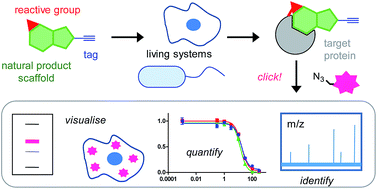
Nat. Prod. Rep., 2016,33, 681-708
https://doi.org/10.1039/C6NP00001K
Design strategies for bioorthogonal smart probes
This review covers approaches used to develop probes activated by bioorthogonal ligation reactions.
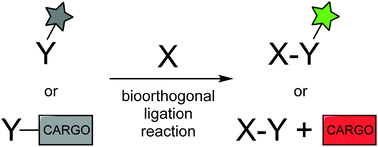
Org. Biomol. Chem., 2014,12, 9307-9320
https://doi.org/10.1039/C4OB01632G
Click chemistry for the synthesis of biobased polymers and networks derived from vegetable oils
Click green chemistry as an efficient functionalization and polymerization method of vegetable oils and their derivatives.
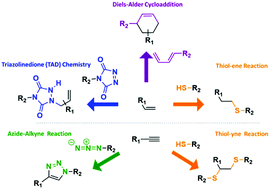
Green Chem., 2021,23, 4296-4327
https://doi.org/10.1039/D1GC00445J
Multicomponent encapsulation into fully degradable protein nanocarriers via interfacial azide–alkyne click reaction in miniemulsion allows the co-delivery of immunotherapeutics
Fully biodegradable protein nanocarriers were prepared by metal-free click reaction in inverse miniemulsion and loaded in situ with up to four different cargo molecules to achieve a synergistic therapeutic treatment.
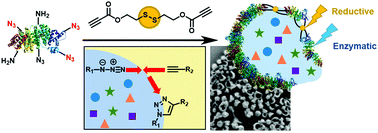
Nanoscale Horiz., 2022,7, 908-915
https://doi.org/10.1039/D2NH00243D
Catalytic machinery in motion: controlling catalysis via speed
The speed and catalytic activity (with regard to a click reaction) of slider-on-deck systems, in which a biped exchanges between three copper(I) centres, is regulated by addition of brake stones.
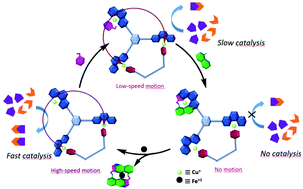
Chem. Commun., 2022,58, 8073-8076
https://doi.org/10.1039/D2CC02555H
Development of sustainable synthesis of glucuronic acid glycodendrimers using ball milling and microwave-assisted CuAAC reaction
Two green strategies for CuAAC reaction based on two activation pathways, solvent free mechanochemistry and microwave irradiation using a recycable biosolvent, are reported for the synthesis of glucuronic acid glycodendrimers with good conversión.

New J. Chem., 2022,46, 6389-6393
https://doi.org/10.1039/D1NJ06132A
Radical-mediated thiol–ene ‘click’ reactions in deep eutectic solvents for bioconjugation
Herein, we report the first application of deep eutectic solvents (DESs) in radical-mediated hydrothiolation reactions.
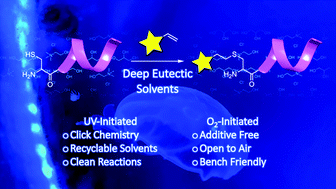
Green Chem., 2022,24, 1456-1462
https://doi.org/10.1039/D1GC03714E
Augmenting photosynthesis through facile AIEgen-chloroplast conjugation and efficient solar energy utilization
Two new AIE molecules with activated alkyne groups were successfully conjugated with live chloroplasts by a facile metal-free “Click” reaction, and the formed artificial AIEgen-chloroplast owned the increased photosynthetic activity.
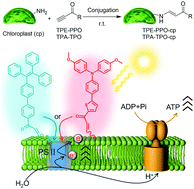
Mater. Horiz., 2021,8, 1433-1438
https://doi.org/10.1039/D1MH00012H
A thermoresponsive crosslinker for reversible micelle stabilization
Herein we report a thermoresponsive crosslinker that can be utilized to stabilize the surface of micelles through “click” reaction and to trigger the disassembly via retro Diels Alder (rDA) mechanism.
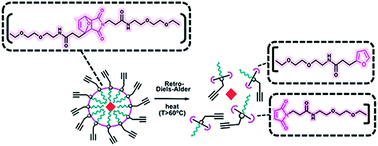
Mater. Adv., 2021,2, 2267-2271
https://doi.org/10.1039/D1MA00089F
C-Terminal lactamization of peptides
New solid-phase based methods have allowed efficient synthesis of natural products and novel peptide hormone derivatives with a C-terminal lactam.
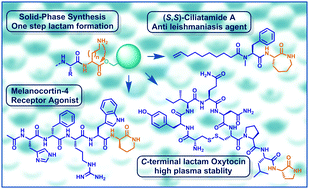
Chem. Commun., 2021,57, 895-898
https://doi.org/10.1039/D0CC06018F
Construction of an IMiD-based azide library as a kit for PROTAC research
As a promising protein degradation strategy, PROTAC technology is increasingly becoming a new star in cancer treatment.

Org. Biomol. Chem., 2021,19, 166-170
https://doi.org/10.1039/D0OB02120B
In cell Gd3+-based site-directed spin labeling and EPR spectroscopy of eGFP
A newly synthesized Gd3+ chelate complex allows in cell spin labeling and detection of eGFP by EPR spectroscopy.
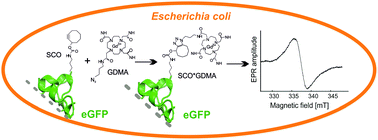
Phys. Chem. Chem. Phys., 2020,22, 13358-13362
https://doi.org/10.1039/D0CP01930E
Fast-forming BMSC-encapsulating hydrogels through bioorthogonal reaction for osteogenic differentiation
An injectable in situ fast-forming hydrogel was fabricated to encapsulate BMSCs for osteogenic differentiation through the inverse electron demand Diels–Alder click reaction between trans-cyclooctene-modified PEG and tetrazine-modified hyaluronic acid.

Biomater. Sci., 2018,6, 2578-2581
https://doi.org/10.1039/C8BM00689J
CuAAC click chemistry: a versatile approach towards PVDF-based block copolymers
Functionalized benzoyl peroxide-initiated polymerization of vinylidene fluoride allows straightforward preparation of PVDF-based block copolymers with an appealing crystallization behavior.
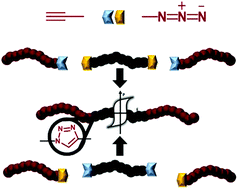
Polym. Chem., 2018,9, 3714-3720
https://doi.org/10.1039/C8PY00742J
A fluorogenic screening platform enables directed evolution of an alkyne biosynthetic tool
A fluorogenic screening platform enabled the engineering of a membrane-bound bifunctional desaturase/acetylenase for improved activity in E. coli.
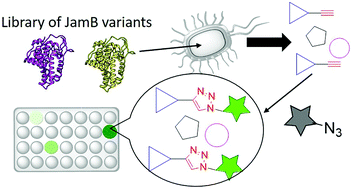
Chem. Commun., 2016,52, 11239-11242
https://doi.org/10.1039/C6CC05990B
Monodisperse functional microspheres from step-growth “click” polymerizations: preparation, functionalization and implementation
We introduce a new paradigm in microparticles, where “click” chemistry enables the fabrication of functional monodisperse microspheres from step-growth polymerization at ambient conditions.
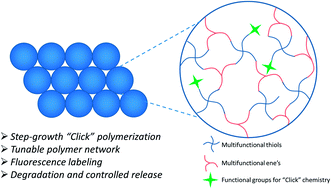
Mater. Horiz., 2014,1, 535-539
https://doi.org/10.1039/C4MH00082J
Gold(I) “click” 1,2,3-triazolylidenes: synthesis, self-assembly and catalysis
Novel gold(I) “click” carbene(1,2,3-triazolylidene) complexes have been synthesised, characterised and exploited for the self-assembly of a metallomacrocycle and as precatalysts for gold(I)-catalysed reactions.
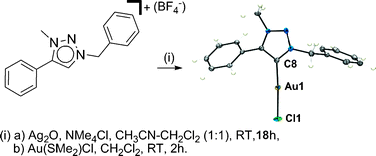
Chem. Commun., 2011,47, 328-330
https://doi.org/10.1039/C0CC02185G
“Click-switch” – one-step conversion of organic azides into photochromic diarylethenes for the generation of light-controlled systems
New photochromic diarylethenes are reported in which one aryl ring is a 1,2,3-triazole that is formed by “click” chemistry between an azide on the target and a matching alkyne–cyclopentene–thiophene component.

Chem. Sci., 2021,12, 11593-11603
https://doi.org/10.1039/D1SC02526K
Synthetic methodology towards allylic trans-cyclooctene-ethers enables modification of carbohydrates: bioorthogonal manipulation of the lac repressor
Two novel reagents were developed to direct formation of allylic cis-cyclooctene (CCO) ethers, followed by photochemical isomerization to obtain trans-cyclooctene (TCO) ethers. The method was used to cage a bio-active carbohydrate.

Chem. Sci., 2020,11, 10175-10179
https://doi.org/10.1039/D0SC03216F
TMTHSI, a superior 7-membered ring alkyne containing reagent for strain-promoted azide–alkyne cycloaddition reactions
TMTHSI was developed as new reagent for strain-promoted azide–alkyne cycloaddition reactions, enabling connection of a diversity of small to large molecular constructs.
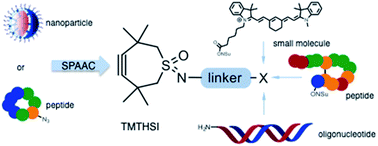
Chem. Sci., 2020,11, 9011-9016
https://doi.org/10.1039/D0SC03477K
Synthesis of unsymmetrical sulfamides and polysulfamides via SuFEx click chemistry
A general, practical, and efficient synthesis of N,N′-disubstituted sulfamides has been developed and applied to the preparation of polysulfamides, a virtually unknown class of polymers.
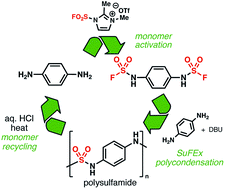
Chem. Sci., 2020,11, 7807-7812
https://doi.org/10.1039/D0SC03606D
The hunt for reactive alkynes in bio-orthogonal click reactions: insights from mechanochemical and conceptual DFT calculations
The force required to bend alkynes increases linearly with the angle and depends on the substituent pattern. The reactivity of the triple bond does not readily increase and is less influenced by the substituent pattern for larger bends.
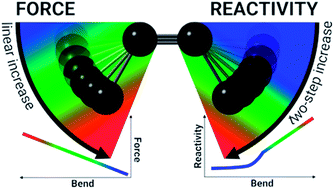
Chem. Sci., 2020,11, 1431-1439
https://doi.org/10.1039/C9SC04507D
Vinylphosphonites for Staudinger-induced chemoselective peptide cyclization and functionalization
Vinylphosphonites react in chemoselective Staudinger-phosphonite reactions (SPhR) with azides to form vinylphosphonamidates for the subsequent modification of cysteine residues in peptides and proteins.

Chem. Sci., 2019,10, 6322-6329
https://doi.org/10.1039/C9SC01345H
Site-specific PEGylation of proteins by a Staudinger-phosphite reaction
A Staudinger-phosphite ligation was applied for an efficient, metal-free PEGylation of azido-polypeptides yielding stable and light-cleavable branched oligoethylene glycol scaffolds.

Chem. Sci., 2010,1, 596-602
https://doi.org/10.1039/C0SC00324G
Nucleic acid-based supramolecular structures: vesicular spherical nucleic acids from a non-phospholipid nucleolipid
An original hybrid biomacromolecule, consisting of a lipid-mimetic residue and a 21-base long nucleic acid strand, spontaneously self-associates and co-associates with other lipids into nucleic acid-grafted vesicular structures.

Nanoscale Adv., 2022,4, 3793-3803
https://doi.org/10.1039/D2NA00527A
Introducing SuFEx click chemistry into aliphatic polycarbonates: a novel toolbox/platform for post-modification as biomaterials
It is the first time to introduce SuFEx click chemistry into aliphatic polycarbonates. Moreover, the one-pot strategy of ring-opening polymerization of cyclic carbonate and SuFEx click reactions for functionalization could be directly achieved.
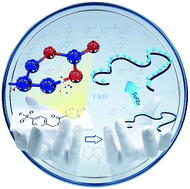
J. Mater. Chem. B, 2022,10, 5203-5210
https://doi.org/10.1039/D2TB01052F
Development of a multistep, electrochemical flow platform for automated catalyst screening
An integrated flow platform enables the electrochemical synthesis of base-metal catalysts with high-throughput screening and rapid data generation.
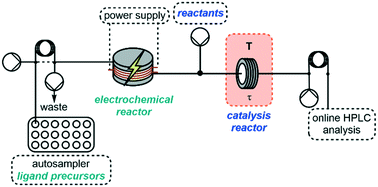
Catal. Sci. Technol., 2022,12, 4266-4272
https://doi.org/10.1039/D2CY00587E
Accelerated synthesis of dendrimers by thermal azide–alkyne cycloaddition with internal alkynes
Optimized reaction conditions and a strict alignment to green chemistry principles allow the accelerated preparation of a G5 dendrimer in less than 12 h by combining the thermal azide–alkyne cycloaddition and azide substitution reactions.
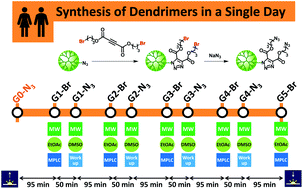
Green Chem., 2022,24, 4897-4901
https://doi.org/10.1039/D2GC00473A
Enzyme-triggered click chemistry combined with surface-enhanced Raman spectroscopy for the simple and sensitive detection of alkaline phosphatase activity from complex biological samples
Schematic of the enzyme-triggered click chemistry combined with the SERS technique for ALP detection.
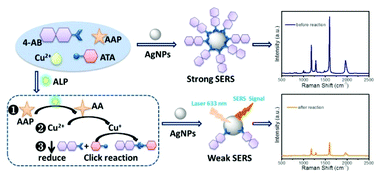
Analyst, 2022,147, 2494-2499
https://doi.org/10.1039/D1AN02159A
Synthesis and preliminary evaluation of octreotate conjugates of bioactive synthetic amatoxins for targeting somatostatin receptor (sstr2) expressing cells
Synthetic amanitin is conjugated to octreotate as a targeting agent: three different linkers and two sites of attachment highlight a robust chemical approach leading to targeted cytotoxicity.
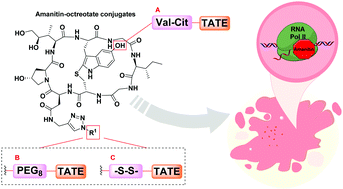
RSC Chem. Biol., 2022,3, 69-78
https://doi.org/10.1039/D1CB00036E
SPAAC iClick: progress towards a bioorthogonal reaction in-corporating metal ions
Combining strain-promoted azide–alkyne cycloaddition (SPAAC) and inorganic click (iClick) reactivity provides access to metal 1,2,3-triazolates.
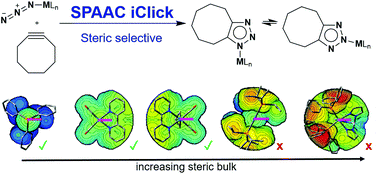
Dalton Trans., 2021,50, 12681-12691
https://doi.org/10.1039/D1DT02626G
Radiolabelling an 18F biologic via facile IEDDA “click” chemistry on the GE FASTLab™ platform
A fully automated and efficient radiosynthesis of a novel interleukin-2 radioconjugate from a single FASTLab™ cassette.
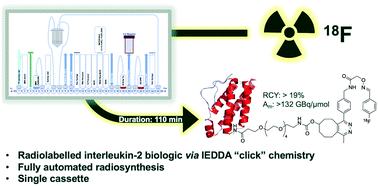
React. Chem. Eng., 2021,6, 1070-1078
https://doi.org/10.1039/D1RE00117E
The liquid crystal Click procedure for oligothiophene-tethered phthalocyanines – self-assembly, alignment and photocurrent
The Click process for oligothienyl star mesogens generates triple nanosegregated columnar LCs – partial homeotropic alignment leads to increased photocurrents.
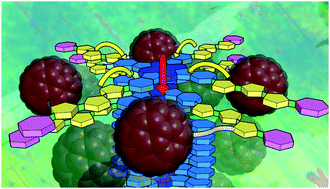
J. Mater. Chem. C, 2021,9, 5689-5698
https://doi.org/10.1039/D1TC00710F
Defect engineering: an effective tool for enhancing the catalytic performance of copper-MOFs for the click reaction and the A3 coupling
A series of Cu(I)-enriched and Lewis basic site-containing defect-engineering MOFs was investigated for significantly enhanced catalytic performance in the click reaction and the A3 coupling.
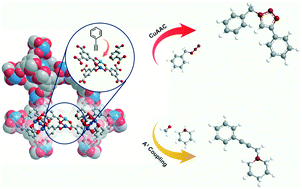
Catal. Sci. Technol., 2021,11, 2396-2402
https://doi.org/10.1039/D0CY01946A
Copper(II) complexes of N-propargyl cyclam ligands reveal a range of coordination modes and colours, and unexpected reactivity
Copper(II) complexes of cyclam ligands with 1, 2, 3 or 4 pendant alkynes have been prepared and characterised crystallographically and spectroscopically. An unexpected hydroalkoxylation reaction is observed, affording an enol ether from the alkyne.
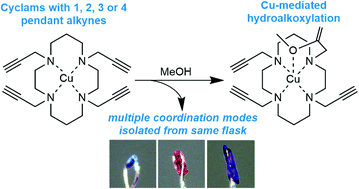
Dalton Trans., 2021,50, 3931-3942
https://doi.org/10.1039/D0DT03736B
The stepwise organization of nanoparticles into a Pickering emulsion
Homogeneous composite nanoparticles undergo stepwise organization from individual nanoparticles that capture oil to stable aggregates to the formation of a Pickering emulsion as oil is continuously fed into the aqueous dispersion.

Soft Matter, 2021,17, 1796-1801
https://doi.org/10.1039/D0SM02028A
Cancer cell-targeted cisplatin prodrug delivery in vivo via metabolic labeling and bioorthogonal click reaction
DCL-AAM selectively labels cancer cells with azido groups, and thus allows tumor-targeted delivery of DBCO-cisplatin prodrug via bioorthogonal click chemistry.
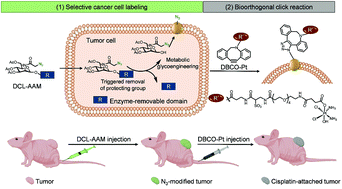
Biomater. Sci., 2021,9, 1301-1312
https://doi.org/10.1039/D0BM01709D
Selective analysis of newly synthesized proteins by combining fluorescence correlation spectroscopy with bioorthogonal non-canonical amino acid tagging
FCS with the BONCAT strategy is a promising approach for analysis of newly synthesized proteins and also be extended to further application for studying physiological or pathological processes related to proteins or other metabolic molecular changes.
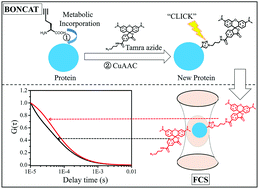
Analyst, 2021,146, 478-486
https://doi.org/10.1039/D0AN01697G
In vivo vocal fold augmentation using an injectable polyethylene glycol hydrogel based on click chemistry
A click chemistry-based PEG hydrogel was applied for vocal fold augmentation in vivo. In rabbit models, it stably fixed the paralyzed vocal fold and minimized the glottic gap.
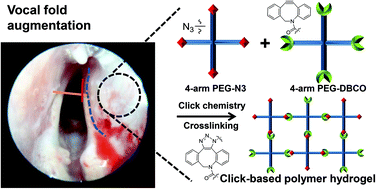
Biomater. Sci., 2021,9, 108-115
https://doi.org/10.1039/D0BM01155J
Tetrazine- and trans-cyclooctene-functionalised polypept(o)ides for fast bioorthogonal tetrazine ligation
Tetrazine- and trans-cyclooctene-functionalised polypeptides and polypetoids were prepared by ring-opening polymerisation of N-carboxyanhydrides using the respective functional initiators and shown to react in fast bioorthogonal tetrazine ligations.

Polym. Chem., 2020,11, 4396-4407
https://doi.org/10.1039/D0PY00375A
Water-soluble silicon nanocrystals as NIR luminescent probes for time-gated biomedical imaging
In vivo studies demonstrated tumor accumulation of luminescent SiNCs, 48 hours clearance and a 3-fold improvement of signal-to-noise ratio in time-gated imaging compared to steady-state acquisition, demonstrating their potentiality for luminescence guided surgery.
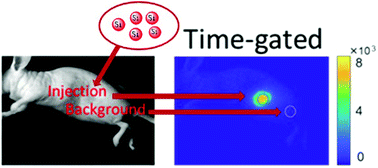
Nanoscale, 2020,12, 7921-7926
https://doi.org/10.1039/D0NR00814A
Click chemistry-based imaging to study the tissue distribution of the curcumin–protein complex in mice
Using click chemistry-based fluorescence imaging, here we show that curcumin, a bioactive dietary compound with a thiol-reactive α,β-unsaturated carbonyl moiety, can covalently modify protein thiols in colon and liver tissues in mice.
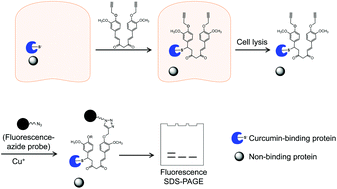
Food Funct., 2020,11, 1684-1691
https://doi.org/10.1039/C9FO02012H
The first thiol–yne click chemistry approach for the preparation of liquid crystalline elastomers
A new synthetic strategy based on thiol–yne click chemistry is presented to prepare liquid crystalline elastomers, allowing us to obtain mixed side-chain/main-chain structures able to undergo contraction up to 48%.
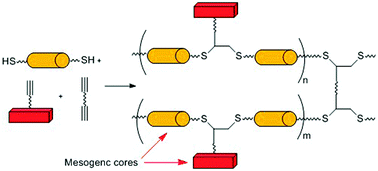
J. Mater. Chem. C, 2015,3, 9003-9010
https://doi.org/10.1039/C5TC01290B
Direct and two-step bioorthogonal probes for Bruton's tyrosine kinase based on ibrutinib: a comparative study
Direct and two-step activity-based probes allow for profiling of Bruton's tyrosine kinase in vitro and in situ.
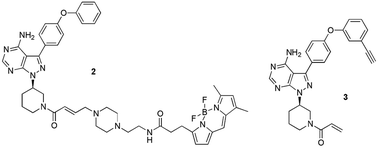
Org. Biomol. Chem., 2015,13, 5147-5157
https://doi.org/10.1039/C5OB00474H
Design of thiol–ene photoclick hydrogels using facile techniques for cell culture applications
Thiol–ene photoclick hydrogels with tunable biomechanical and biochemical properties for biological applications, including controlled cell culture, regenerative medicine, and drug delivery.

Biomater. Sci., 2014,2, 1612-1626
https://doi.org/10.1039/C4BM00187G
Efficient metabolic oligosaccharide engineering of glycoproteins by UDP-N-acetylglucosamine 2-epimerase /N-acetylmannosamine kinase (GNE ) knock-down
Efficient incorporation of chemically modified sugar analogues into cell surface glycans and recombinantly expressed CEACAM was achieved by shRNA-mediated knock down of the key enzyme of sialic acid biosynthesis.
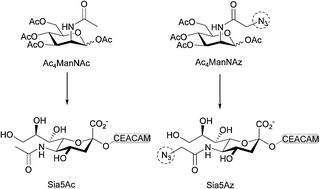
Mol. BioSyst., 2011,7, 2245-2251
https://doi.org/10.1039/C1MB05059A
[(NHC)CuX ] complexes: Synthesis, characterization and catalytic activities in reduction reactions and Click Chemistry. On the advantage of using well-defined catalytic systems
A thorough synthetic and catalytic study of [(NHC)CuX] complexes led to major improvements for this family of compounds.
![Graphical abstract: [(NHC)CuX] complexes: Synthesis, characterization and catalytic activities in reduction reactions and Click Chemistry. On the advantage of using well-defined catalytic systems](/en/Image/Get?imageInfo.ImageType=GA&imageInfo.ImageIdentifier.ManuscriptID=C0DT00218F&imageInfo.ImageIdentifier.Year=2010)
Dalton Trans., 2010,39, 7595-7606
https://doi.org/10.1039/C0DT00218F
Covalent and orthogonal multi-functionalization of terpolymers
A unique methodology for the quantitative multi-functionalization of terpolymers has been developed via highly efficient and versatile covalent synthetic strategies using click reactions: maleimide–thiol coupling, 1,3-dipolar cycloaddition, and hydrazone formation.
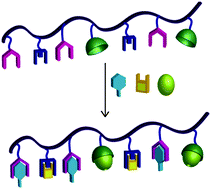
Soft Matter, 2009,5, 582-585
https://doi.org/10.1039/B813675K
A simple and efficient method for epoxidation of terminal alkenes
α-Vinyl azide–cysteine click coupling reaction enabled bioorthogonal peptide/protein modification
α-Alkyl and α-aryl vinyl azides were found to be able to couple with cysteine-derived alkyl thiols chemoselectively under mild conditions, providing the corresponding β-ketosulfides with simultaneous extrusion of N2 and ammonia.

Org. Chem. Front., 2022,9, 4654-4662
https://doi.org/10.1039/D2QO00736C
Development of 2-deoxystreptamine–nucleobase conjugates for the inhibition of oncogenic miRNA production
2-deoxystreptamine (2-DOS) conjugates with artificial nucleobases were designed and synthesized to inhibit pre-miR-372 processing into oncogenic miRNA and were discovered to be promising inhibitors when compared to their neomycin counterpart.
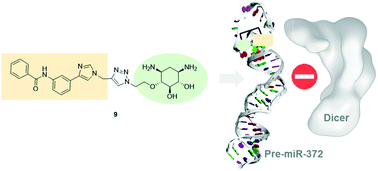
RSC Med. Chem., 2022,13, 311-319
https://doi.org/10.1039/D1MD00345C
Metabolic labelling of cancer cells with glycodendrimers stimulate immune-mediated cytotoxicity
Combining glycometabolism and bio-orthogonal chemistry to label cells with antigenic glycodendrimers lead to the activation of immune response against cancer cells.

RSC Med. Chem., 2022,13, 72-78
https://doi.org/10.1039/D1MD00262G
Prolinamide plays a key role in promoting copper-catalyzed cycloaddition of azides and alkynes in aqueous media via unprecedented metallacycle intermediates
Room temperature copper-catalyzed cycloaddition of azides and alkynes (CuAAC) proceeds in the presence of a prolinamide ligand in aqueous media via unique metallacycles.

Org. Chem. Front., 2021,8, 2434-2441
https://doi.org/10.1039/D0QO01150A
About this collection
This cross-journal collection is dedicated to bioorthogonal and click chemistry, in honour of the 2022 Nobel Prize in Chemistry. Click chemistry is best represented by its most elegant and widespread example, the copper catalysed azide-alkyne cycloaddition (CuAAC). Bioorthogonal reactions are click reactions that take place without disrupting the normal chemistry of the cell, inside living organisms, and these are now used to track biological processes. The scope of this collection highlights key historic works in bioorthogonal and click chemistry alongside showcasing recent developments and applications of these now ubiquitous techniques.